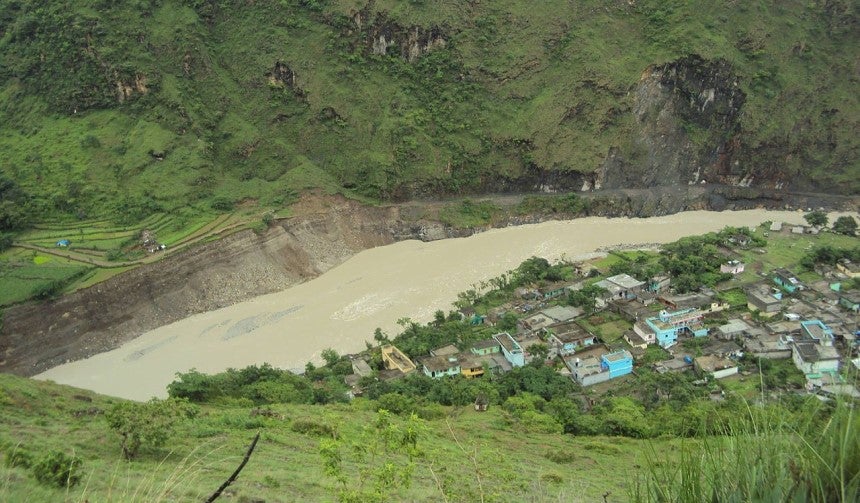India-Nepal Border Bridge Construction: Some Relief but More Needed
Amit Ranjan
18 January 2022Summary
After its construction, the newly-approved bridge by the Indian government will make border crossing between the Indian and Nepali side of Dharchula more convenient. However, it may not address perennial problems.
On 6 January 2022, the Indian cabinet approved the signing of a memorandum of understanding with Nepal in the “near future” for the construction of a steel bridge over River Mahakali at Malla Charchum village near the town of Dharchula in Pithoragarh district in the Indian state of Uttarakhand. It will be 110 metres long and 10.50 metres wide with a 7.5 metres carriageway. The bridge will be completed within three years at a cost of around ₹46.06 crore (S$8.3 million). It will link Dharchula in India with Nepal’s Dharchula. This will be the second motor bridge on the India-Nepal border in Uttarakhand, after the Banbasa bridge in the Champawat district.
To help the people living along the border and in a response to Nepal’s proposal of constructing 11 suspension bridges to replace tuins (traditional wire river crossings) in 2019, India gave a green signal to construct four suspension bridges across the Mahakali river in Dharchula. However, it stipulated that Nepal would build a security check post or guardroom alongside the bridges on the Indian side for Sashastra Seema Bal (SSB), the Indian paramilitary force that monitors India’s borders with Nepal and Bhutan.
Due to lack of connecting bridges, every year, several cases of accidents and deaths are reported of people trying to cross the river using tuins, wooden boats, tyre tubes or wooden logs. One such recent case – which stirred political trouble between India and Nepal – was the disappearance of a 33-year-old migrant worker, Jaya Singh Dhami. On 30 July 2021, Dhami disappeared while trying to cross River Mahakali using a tuin to get into the Indian side of the border. He had to go to Khalanga, the district headquarters, from where Dhami had planned to travel to Kathmandu. According to eyewitnesses, a member of SSB detached the metal cable from a tree supporting the cable crossing just when Dhami had almost reached the other side of the border. Consequently, Dhami fell in the swollen river and was swept away.
The SSB has, however, has refuted such an accusation, arguing that Dhami died/disappeared after two other men from Nepal who had crossed into the Indian side cut the wire after spotting the SSB patrolling team coming towards them. The SSB personnel said:
“The Nepalese citizens often use such improvised river crossing mechanisms using iron wire [tuin]…The Nepalese citizens tie one end of the iron wire to a tree or pole on their side, while the other end is tied to a tree on the Indian side across the river by their Indian aides here. They then attach a pulley to the wire and slide across the river while sitting inside an improvised metal drum, which is tied to the pulley with a rope. They cross into the Indian side for business and other purposes.”
After Dhami’s disappearance, Indian media quoted Arindam Bagchi, spokesperson of India’s Ministry of External Affairs, as saying, “We have heard about the incident through some media, but no official information has been shared with us yet.” After that, Nepal sent two diplomatic notes through the Indian embassy in Kathmandu requesting the Indian government to launch a detailed investigation into the involvement of SSB personnel in the disappearance of Dhami and compensation to his family. In a separate note, Nepal’s Ministry of Foreign Affairs called on the Indian embassy to communicate on an Indian chopper flying in Nepali skies with the concerned authorities in New Delhi.
Kathmandu’s inaction or slow action was not received well by some critics of Prime Minister Sher Bahadur Deuba, who were “quick to charge” him for being “servile” to New Delhi. Instead of taking up the issue with New Delhi, initially, the Nepal Ministry of Home Affairs issued a statement asking the media and others to not spread “misleading” information about the incident. In addition, the Nepali government issued a warning to the protesting students who burnt the effigies of India’s Prime Minister Narendra Modi.
After Dhami’s accident, a somewhat similar historical incident of 1960 was discussed in the Nepali media. When a Nepali citizen was “mistakenly” killed by Chinese troops, the Nepal’s government raised the matter so assertively that China not only apologised for the mistake but also agreed to compensate the damage in the terms set by Nepal. B P Koirala, founder of the Nepali Congress, took up the issue with the Chinese authorities.
More than India-Nepal political equations and India’s “insensitivity”, Dhami’s case shows how the region has been neglected by Kathmandu. There is a lack of basic facilities in Nepal’s Dharchula, forcing people to be highly dependent on India. People from the region go to India to buy essential goods, get treatment for minor illness or injuries and earn their livelihood. Even to reach their district headquarters, they have to first enter Indian territory.
Following its construction, the new bridge will certainly bring considerable relief and convenience to the people of Dharchula. However, unless the region is better developed, problems will continue to persist.
. . . . .
Dr Amit Ranjan is a Research Fellow at the Institute of South Asian Studies (ISAS), an autonomous research institute at the National University of Singapore (NUS). He can be contacted at isasar@nus.edu.sg. The author bears full responsibility for the facts cited and opinions expressed in this paper.
Photo credit: Wikimedia Commons.
-
 More From :
More From :
-
 Tags :
Tags :
-
 Download PDF
Download PDF



